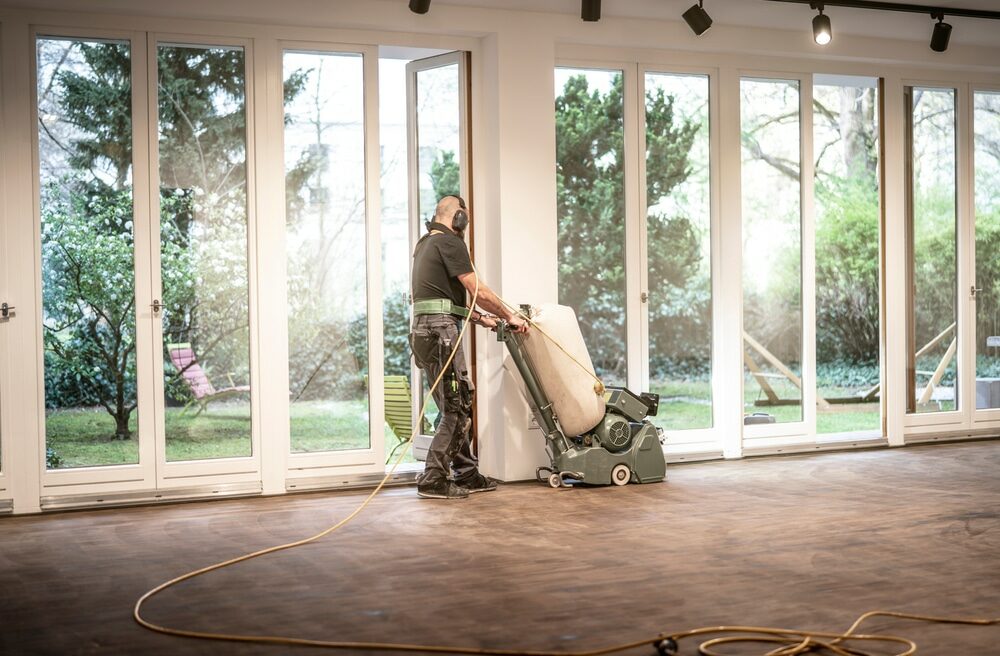London:
Nationwide:
Jet Washing Decking: Is it a Good Idea?
Posted on December 26, 2023
Deck Maintenance
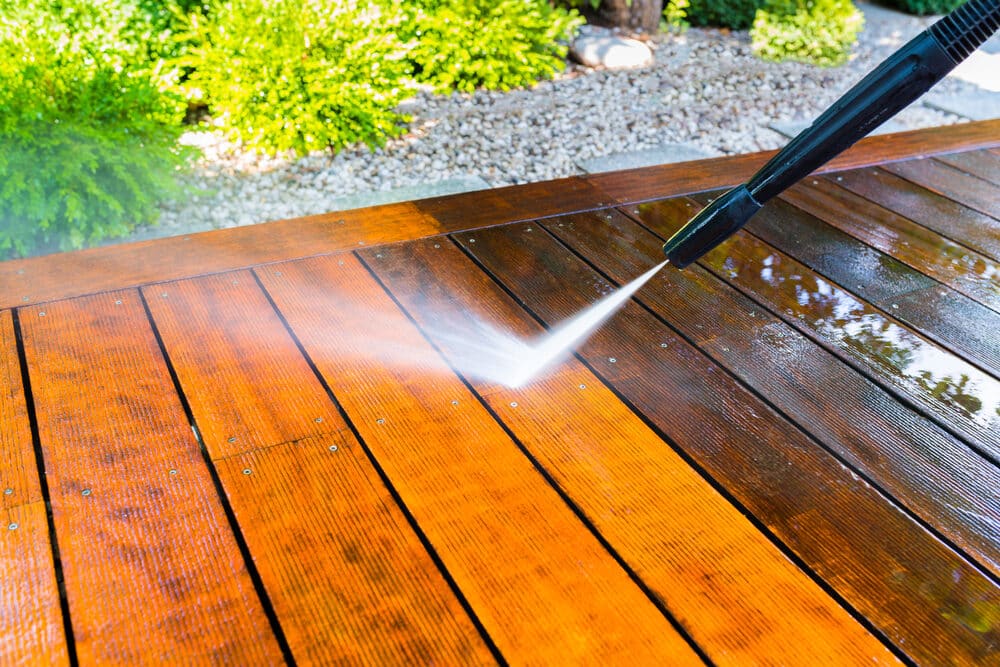
Is Jet Washing Deck a Wise Choice?
A well-maintained deck can be a beautiful and functional extension of your home, providing the perfect spot for outdoor gatherings, relaxation, and soaking up the sun. However, as time passes and the elements take their toll, even the most pristine decks can start to show signs of wear and tear. Fading, dirt, algae, and stubborn stains can detract from the aesthetic appeal of your outdoor space, making it less inviting and potentially compromising its longevity.
Enter jet washing, a powerful cleaning method that promises to breathe new life into your decking. But is it really a good idea? Is the allure of high-pressure cleaning worth the potential risks and drawbacks? In this comprehensive guide, we’ll dive into the world of jet washing for decking, exploring its benefits, potential pitfalls, when it’s suitable, and how to do it safely and effectively.
Whether you’re a seasoned DIY enthusiast or a homeowner looking to revitalize your outdoor space, we’ll help you make an informed decision about whether jet washing is the right solution for your deck. So, let’s embark on this journey together and uncover the secrets to maintaining a pristine deck that’s ready to impress, season after season.
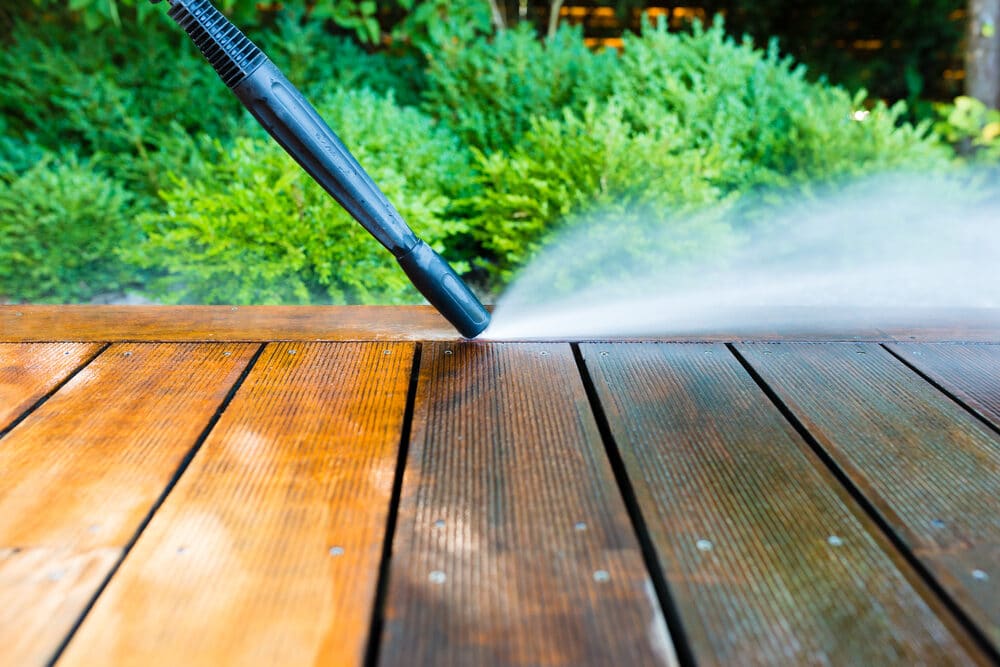
Understanding Decking
Before we dive into the nitty-gritty of jet washing and its implications for your deck, it’s crucial to have a solid understanding of what decking is and why it’s such an essential element of your outdoor space. By doing so, you’ll be better equipped to make informed decisions about decking maintenance and cleaning.
What Is Decking, and Why Is It Important?
Decking, in its simplest form, is a flat, elevated surface typically constructed from wood, composite materials, or PVC. It is an integral part of many outdoor living spaces and serves several essential functions:
1. Outdoor Entertainment: Decks provide an ideal setting for outdoor gatherings, barbecues, parties, and other social activities. They extend your living space into the great outdoors, offering a versatile area for relaxation and entertainment.
2. Aesthetic Appeal: Well-designed decks enhance the visual appeal of your home and garden. They can be customized to match your architectural style and personal preferences, contributing to the overall beauty of your property.
3. Property Value: A properly maintained deck can add significant value to your home. It’s often a sought-after feature for prospective homebuyers, making it a wise investment.
4. Functionality: Decks offer a flat, even surface for various outdoor activities, from sunbathing and reading to dining and gardening. They can be designed with features like built-in seating, planters, and lighting for added functionality.

Common decking materials
To fully appreciate the nuances of maintaining and cleaning your deck, it’s essential to be aware of the different materials commonly used for decking:
1. Wood: Traditional wooden decks are known for their natural beauty and classic charm. Common wood types include cedar, redwood, pine, and pressure-treated lumber. Wood decks require regular maintenance to prevent decay, rot, and weathering.
2. Composite: Composite decking is a popular alternative to wood, made from a combination of wood fibers and plastic. It offers durability, low maintenance, and resistance to rot and insect damage. Composite decks often mimic the look of wood without the associated upkeep.
3. PVC (Polyvinyl Chloride): PVC decking is entirely synthetic and exceptionally resistant to moisture, fading, and staining. It requires minimal maintenance, making it a hassle-free option for homeowners.
Understanding your decking material is crucial because different materials may react differently to cleaning methods like jet washing. In the following sections, we’ll explore whether jet washing is suitable for various decking types and how to make the best choice for your specific deck.
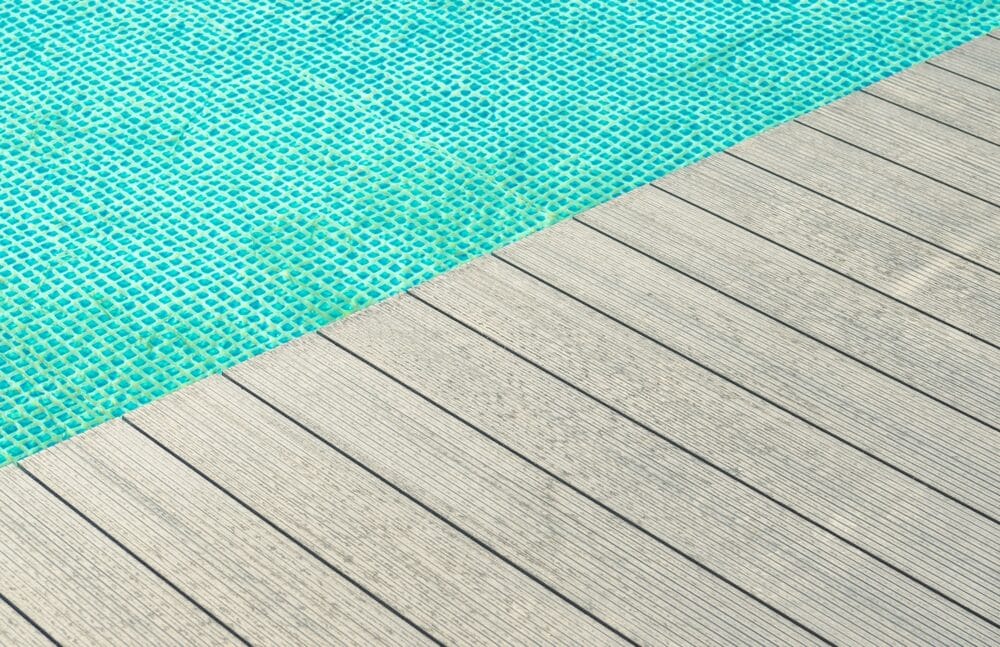
The Benefits of Jet Washing
Jet washing, also known as pressure washing, is a powerful cleaning technique that utilizes high-pressure water to remove dirt, grime, algae, moss, and stubborn stains from surfaces. When it comes to deck maintenance, jet washing offers several compelling advantages:
1. Exploring the Power of High-Pressure Cleaning
Jet washing is remarkably effective at deep cleaning decks. The high-pressure water stream can penetrate tiny crevices, removing accumulated dirt and debris that might be difficult to reach with other cleaning methods. This thorough cleaning can restore your deck’s original luster, making it look almost brand new.

2. Cleaning Efficiency and Time Savings
One of the standout benefits of jet washing is its efficiency. It can significantly reduce the time and effort required to clean a deck compared to manual scrubbing or other cleaning methods. What might take hours of backbreaking work can often be accomplished in a fraction of the time with a pressure washer.
3. Eco-Friendly Considerations
In many cases, jet washing can be an environmentally friendly option for cleaning your deck. Unlike some chemical cleaning agents that may harm the environment, pressure washing typically relies on water alone. This means you can achieve a thorough clean without introducing harmful chemicals into your outdoor space.
4. Algae and Moss Removal
Decks in shaded or damp areas are prone to algae and moss growth, which can make surfaces slippery and unsightly. Jet washing effectively blasts away these unwanted growths, improving safety and restoring the deck’s appearance.
5. Preparation for Sealing or Staining
If you plan to apply a fresh coat of sealant or stain to your deck, jet washing is an excellent way to prepare the surface. It removes old coatings, dirt, and contaminants, ensuring that the new finish adheres properly and provides maximum protection.
While the benefits of jet washing are undeniable, it’s essential to approach this cleaning method with caution, especially when dealing with different types of decking materials. In the next section, we’ll delve into the potential risks and drawbacks associated with jet washing to help you make an informed decision.
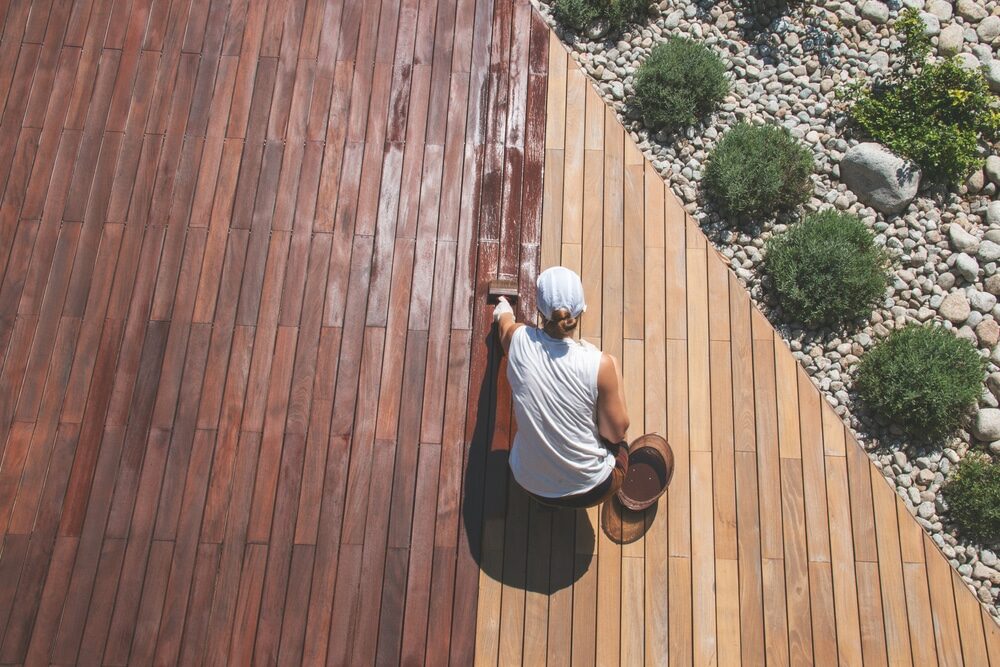
Potential Risks and Drawbacks
While jet washing offers numerous benefits for cleaning and rejuvenating your deck, it’s essential to be aware of the potential risks and drawbacks associated with this high-pressure cleaning method. Here are some key considerations:
1. Impact on Decking Material
a. Wood Decks: High-pressure water can be too aggressive for certain wood types, such as softwoods like pine. It may cause splintering, etching, or even permanent damage to the wood surface. Hardwood decks, like cedar and redwood, may be more resilient but can still be vulnerable if excessive pressure is applied.
b. Composite and PVC Decks: While these materials are generally more durable than wood, excessive pressure can still cause surface damage, including scratching or color fading.
2. High-Pressure Concerns
a. Surface Erosion: If not used correctly, high-pressure water can erode the decking material over time, leading to a rougher texture and a reduced lifespan.
b. Water Intrusion: Intense water pressure can force water into gaps and cracks, potentially causing rot or mildew problems in the long run.
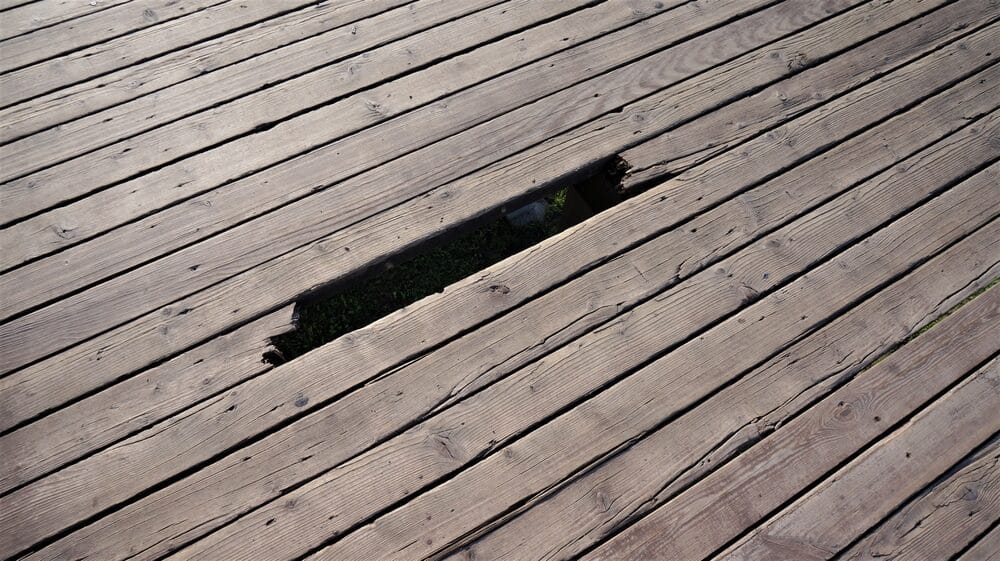
3. Other Risks to Be Aware of
a. Safety Hazards: The powerful stream of water from a pressure washer can be hazardous if not used properly. There’s a risk of injury from the high-pressure spray, so safety precautions are paramount.
b. Environmental Concerns: While pressure washing is often more environmentally friendly than using harsh chemicals, it still consumes a significant amount of water. Care should be taken to minimize water waste.
c. Unsuitable Weather: Jet washing should ideally be done in dry and moderate weather conditions. Using a pressure washer on a wet, slippery deck can increase the risk of accidents.
4. Potential for Overuse
It’s important to note that jet washing is not a one-size-fits-all solution. Overusing this cleaning method, even on materials that can withstand it, can lead to premature wear and tear on the deck. It’s recommended to use jet washing as part of a regular maintenance routine rather than as the sole method for cleaning your deck.
To mitigate these risks and drawbacks, it’s crucial to assess your deck’s condition, choose the appropriate pressure settings, and take the necessary precautions. In the next section, we’ll discuss when jet washing is suitable and how to determine if it’s the right choice for your specific deck.
When is jet washing suitable?
Jet washing can be a highly effective method for cleaning decking, but it’s not always suitable in every situation. To determine if jet washing is the right choice for your specific deck, consider the following factors:
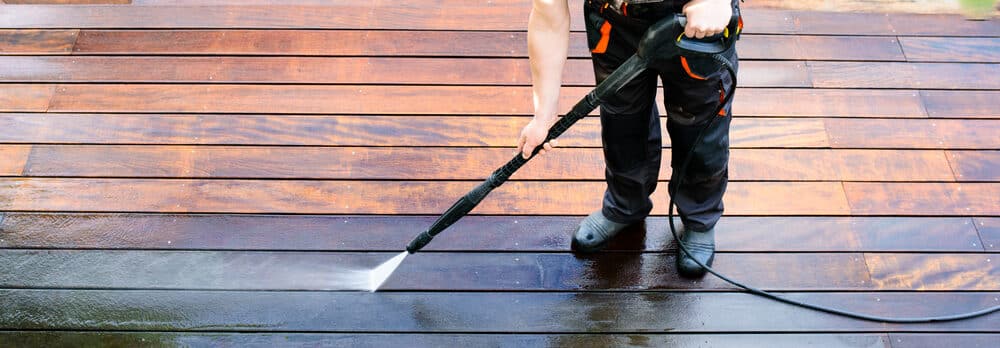
1. Deck Condition Assessment
Before deciding to jet-wash your deck, assess its current condition. Consider the following:
a. Material Type: Identify the type of material your deck is made from. Some materials, like certain hardwoods or composite decking, are more resilient and can withstand jet washing better than others.
b. Age and Wear: Older decks with visible signs of deterioration may require more gentle cleaning methods. Jet washing might not be suitable for a deck with loose boards, significant decay, or structural issues.
c. Previous Maintenance: If your deck has been regularly cleaned and maintained, it may be a better candidate for jet washing. Neglected decks might require more care and potentially additional repairs.
2. Choosing the Right Pressure Settings
When using a pressure washer, it’s essential to select the appropriate pressure settings based on your deck’s material and condition. Lower pressure settings are generally safer for delicate surfaces, while higher pressure settings are suitable for more robust materials. Always start with the lowest pressure setting and gradually increase if needed while testing in an inconspicuous area.
3. Ideal Weather Conditions
The weather can greatly impact the effectiveness and safety of jet washing. Consider the following weather-related factors:
a. Dry Weather: Jet washing should ideally be performed on a dry day. Wet surfaces can be slippery, making the cleaning process less safe.
b. Temperature: Avoid jet washing during extreme temperatures, such as freezing or scorching conditions. Opt for moderate temperatures for the best results.
c. Wind: Strong winds can affect the accuracy and control of the pressure washer’s spray. Choose a day with minimal wind if possible.
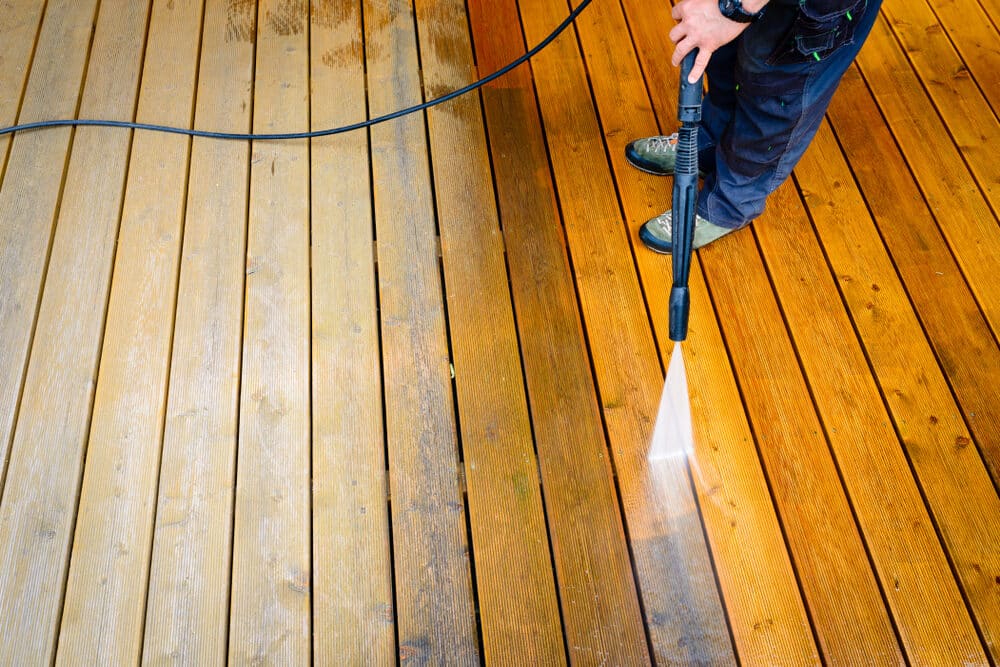
4. Proper Technique and Precautions
To ensure the safe and effective use of a pressure washer, follow these guidelines:
a. Maintain a Safe Distance: Keep the nozzle of the pressure washer at an appropriate distance from the deck surface to prevent damage or injury.
b. Even Pressure Distribution: Maintain consistent pressure across the entire surface to avoid creating uneven spots.
c. Protective Gear: Wear appropriate safety gear, including eye protection and hearing protection if necessary.
d. Testing in an Inconspicuous Area: Before tackling the entire deck, test the pressure washer’s settings on a small, inconspicuous section to ensure it won’t cause damage.
Jet washing can be a valuable tool for maintaining your deck, but its suitability depends on various factors, including your deck’s material, condition, and weather. By carefully assessing these factors and taking the necessary precautions, you can make an informed decision about whether jet washing is the right choice for your deck cleaning needs.
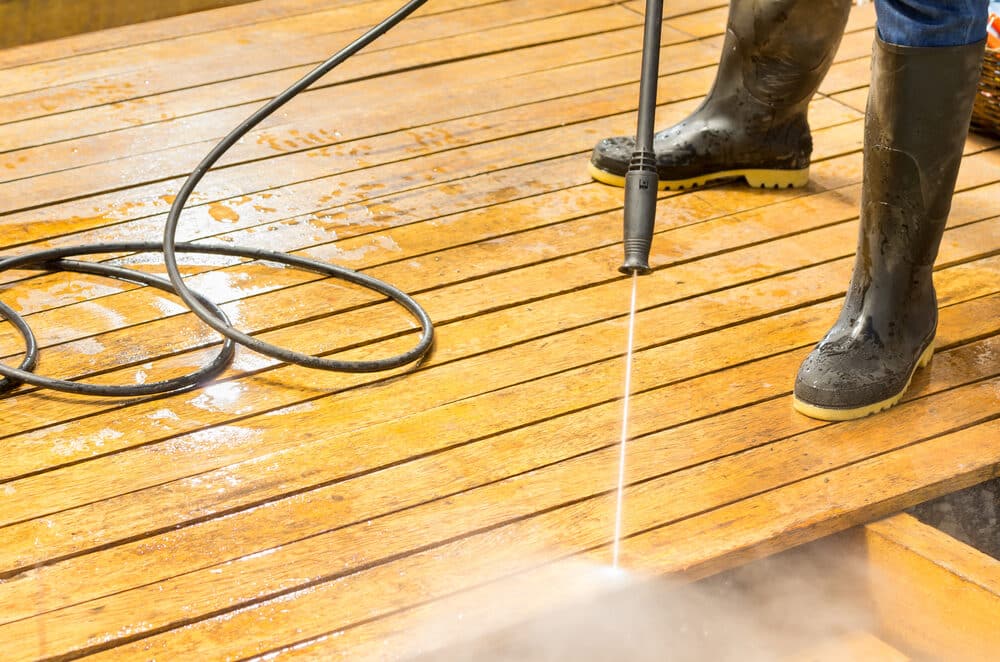
Alternative cleaning methods
While jet washing can be effective for cleaning decks, it’s not the only approach available. Depending on your deck’s material, condition, and personal preferences, you might want to consider alternative cleaning methods. Here are some alternatives to jet washing:
1. Soft washing
Soft washing is a gentler approach that uses low-pressure water combined with specialized detergents to remove dirt, algae, and stains. It’s an excellent choice for more delicate decking materials like wood, as it minimizes the risk of damage. Soft washing can be especially effective when dealing with organic growth and mildew.
2. Scrubbing and chemical cleaning
For light cleaning and spot treatments, you can manually scrub your deck with a stiff brush and a deck-cleaning solution. This method is suitable for removing specific stains or localized dirt buildup. Be sure to follow the manufacturer’s recommendations for any cleaning products you use.
3. Manual cleaning
Sometimes, a good old-fashioned manual cleaning with a hose, a bucket of soapy water, and a brush can be sufficient for routine maintenance. This method is less aggressive and can be an eco-friendly option if you use biodegradable cleaning solutions.
4. Pressure Washer Attachments
If you’re set on using a pressure washer but want to reduce the risk of damage, consider using pressure washer attachments specifically designed for cleaning decks. These attachments disperse the water over a wider area, reducing the pressure and minimizing the risk of surface damage.
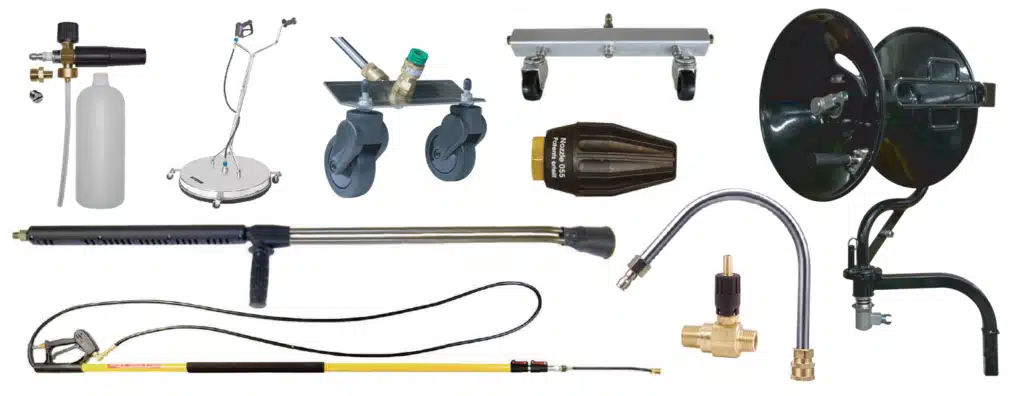
5. Professional Cleaning Services
If you’re uncertain about the best cleaning method for your deck or simply prefer to leave it to the experts, consider hiring professional deck cleaning services. Experienced professionals can assess your deck’s condition, choose the appropriate cleaning method, and ensure the job is done safely and effectively.
6. Regular Maintenance
Prevention is often the best form of maintenance. Implementing a regular cleaning and maintenance schedule for your deck can help prevent the heavy buildup of dirt, algae, and stains. Sweep your deck regularly, remove leaves and debris promptly, and address spills and stains as they occur to reduce the need for extensive cleaning.
Ultimately, the choice of cleaning method should be based on your specific deck’s needs and your comfort level with the cleaning process. Whichever method you choose, remember that proper maintenance is key to keeping your deck in excellent condition and extending its lifespan.
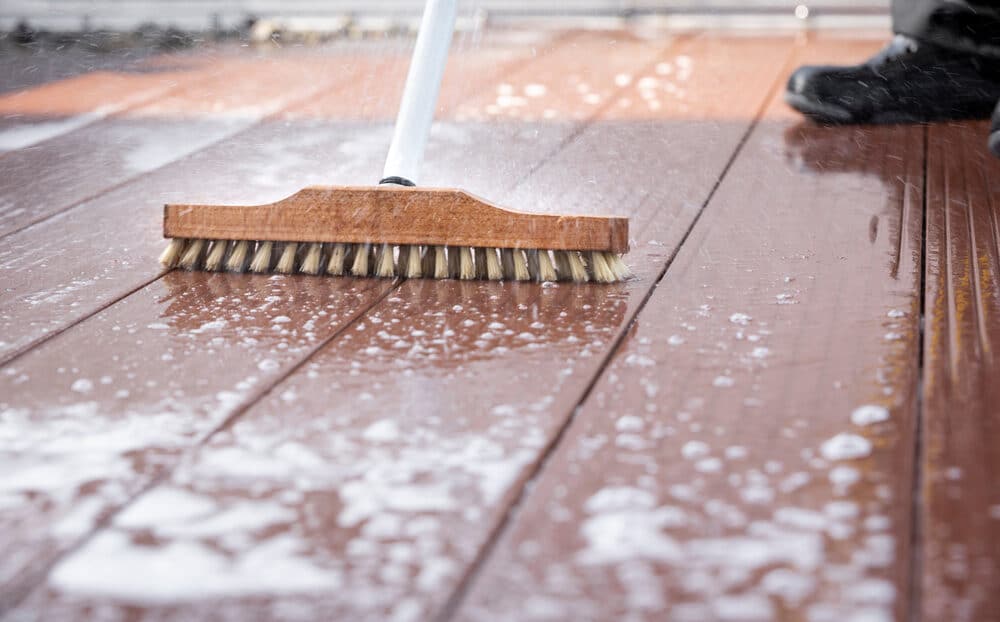
Preparation and Safety Measures
Before you embark on jet washing your deck, it’s crucial to take thorough preparation and safety measures to ensure a successful and accident-free cleaning process. Here’s what you need to do:
1. Gather the necessary equipment.
Make sure you have all the equipment and materials required for jet washing your deck.
- Pressure Washer: Ensure your pressure washer is in good working condition and has an appropriate nozzle for the job.
- Safety Gear: Wear appropriate safety gear, including safety goggles, ear protection, gloves, and non-slip footwear.
- Cleaning Solution: If needed, have the appropriate deck-cleaning solution or detergent on hand. Ensure it’s compatible with your pressure washer and decking material.
- Broom and Brush: You may need a broom and a stiff brush to remove loose debris and dirt from the deck surface before jet washing.
- Water Supply: Make sure you have a reliable water source and a long enough hose to reach all areas of your deck.

2. Safety Gear and Precautions
Your safety should be a top priority when using a pressure washer.
- Eye Protection: Wear safety goggles to protect your eyes from debris and high-pressure water.
- Ear Protection: Pressure washers can be noisy, so consider wearing ear protection to prevent hearing damage.
- Gloves: Protect your hands with sturdy gloves to prevent injury while handling the pressure washer and other equipment.
- Non-Slip Footwear: Wear shoes with good traction to avoid slipping on wet surfaces.
- Appropriate Clothing: Choose clothing that covers your skin to protect against accidental exposure to the high-pressure spray.
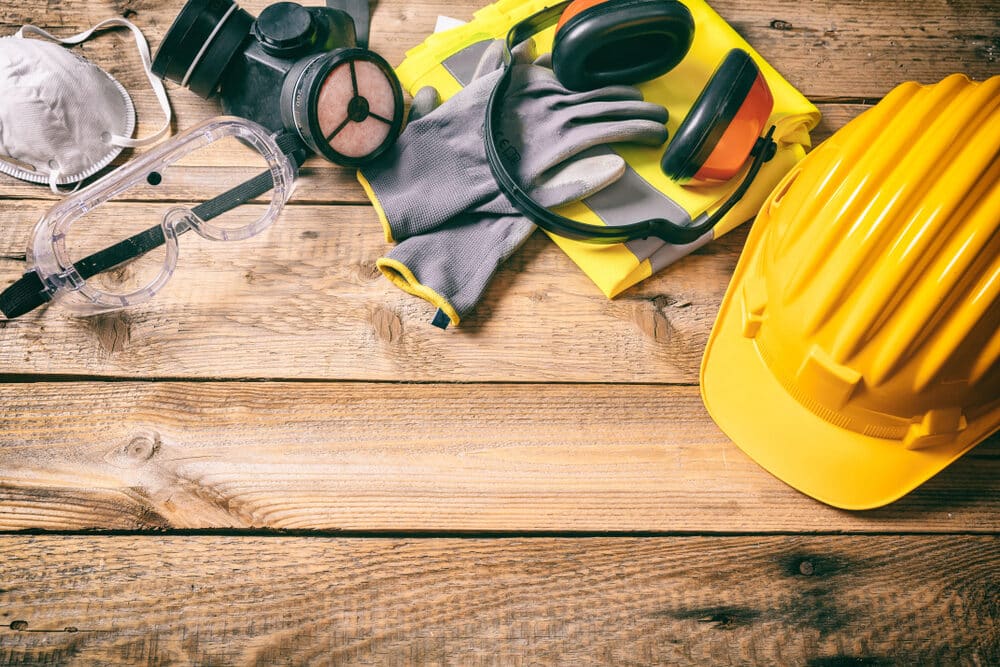
3. Protect nearby plants and structures.
Pressure washing can dislodge dirt, debris, and even small stones, which can potentially damage nearby plants, windows, or other structures. Take these precautions:
- Cover Plants: Use plastic sheeting or drop cloths to cover nearby plants and vegetation. This will shield them from the high-pressure water and any cleaning solutions you might use.
- Close Windows and Doors: Seal off nearby windows and doors to prevent water from entering your home.
4. Clear the deck.
Before you begin jet washing, remove all furniture, decorations, and objects from your deck. This will allow you to clean every surface thoroughly and prevent damage to your belongings.
5. Pre-Clean the Deck
Sweep the deck to remove loose debris, leaves, and dirt. A clean surface will make the jet washing process more effective.
6. Test in an Inconspicuous Area
Before you start jet washing the entire deck, test the pressure washer’s settings on a small, inconspicuous section to ensure it won’t cause damage or discoloration.
7. Follow the manufacturer’s guidelines.
Always read and follow the manufacturer’s guidelines and instructions for your pressure washer and any cleaning solutions you plan to use. This will help you operate the equipment safely and effectively.
By taking these preparation and safety measures, you’ll not only ensure a successful jet washing session but also reduce the risk of accidents or damage to your deck and surroundings. Safety should always be your top priority when using a pressure washer.
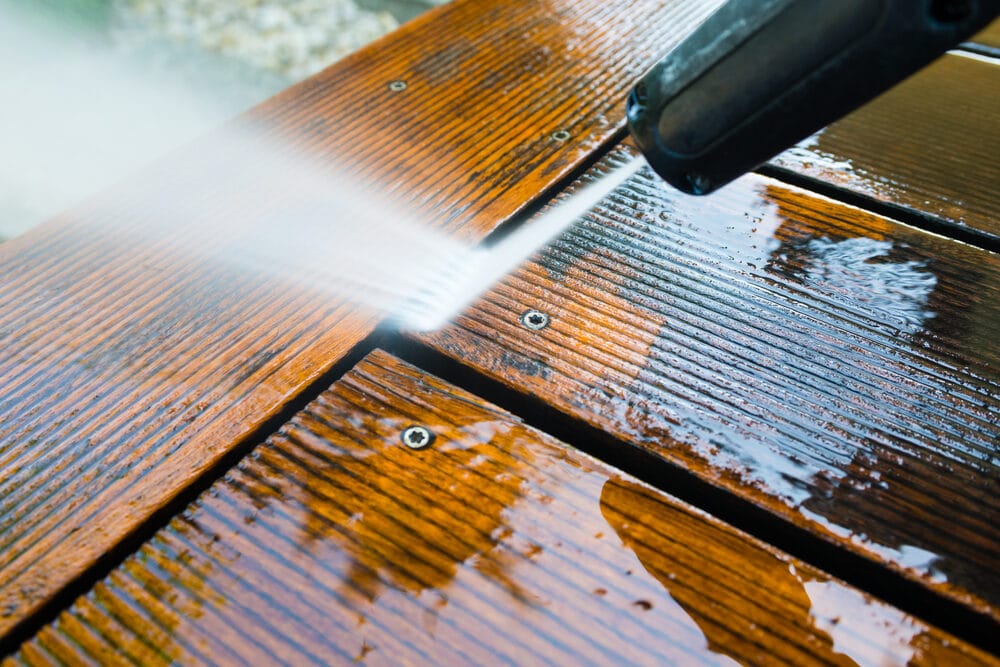
Conclusion
In the pursuit of maintaining a beautiful and functional outdoor space, the decision to jet wash your decking is not one to be taken lightly. As we’ve explored throughout this guide, jet washing offers numerous benefits, including efficient cleaning, the removal of stubborn stains, and the potential for revitalizing your deck’s appearance. However, it also comes with its fair share of risks, especially if not done correctly or on the wrong type of decking material.
Before deciding whether jet washing is the right choice for your deck, consider the following key takeaways:
- Deck Material Matters: The type of material your deck is made from plays a crucial role in determining whether jet washing is suitable. While some materials can withstand high-pressure cleaning, others may be more delicate and prone to damage.
- Proper preparation is essential: Thorough preparation, including safety measures and equipment readiness, is essential before you start the jet washing process. Safety gear, a clean deck surface, and testing in an inconspicuous area are all part of this preparation.
- Regular maintenance is key: To minimize the need for aggressive cleaning methods like jet washing, establish a regular maintenance routine. Sweeping, prompt spill cleanup, and the application of sealants or stains can help preserve your deck’s appearance and longevity.
- Consider Alternatives: Depending on your deck’s condition and material, there are alternative cleaning methods to explore, such as soft washing, manual scrubbing, or professional cleaning services.
In the end, the decision to jet wash your decking should be made with careful consideration of your deck’s unique characteristics and your willingness to follow proper procedures. When done correctly and safely, jet washing can breathe new life into your outdoor space. However, if you have any doubts or concerns, it may be wise to consult a professional or explore alternative cleaning methods.
Remember that maintaining a beautiful deck goes beyond cleaning; it requires ongoing care and attention. With the right approach, you can enjoy your outdoor haven for years to come, whether you choose the power of jet washing or opt for a gentler touch.

Sanding
We provide virtually dust-free sanding with our continuous belt machinery with mobile extraction units, giving you a safer environment for your family.
Oiling
This organic finish not only adds beauty to your home but also has exceptional water-repellent characteristics, making it easier to clean and maintain.
Waxing
This natural floor finish offers the softest and most mellow appearance – and leaves your floor able to breath.
Buffing
Using soft buffing machines (and hand-polishing where required) will bring a wonderful sheen to your newly-finished floor.
Repairs
We offer a full assessment of your wooden floors to determine what repairs are needed to provide the perfect working surface for the later stages of sanding, staining and sealing.
Restoration
We offer a comprehensive restoration process designed to address floors that are improperly fitted or damaged over time through wear and tear.
Request a fixed price quote for your wood floor restoration now
Simply enter your postcode below to get started.
Services
Wood Floor Sanding Wood Floor Restoration Wood Floor Scratch Repair Squeaky Wood Floor Repair Parquet Floor Sanding Parquet Floor Restoration Commercial Floor Sanding Church Floor Sanding Community Centre Floor Sanding School Floor Sanding Gap Filling Gap Filling with ResinCopyright © Mr Sander®
Privacy & Cookies Terms & Conditions Complaints Procedure Cancellation Rights Sitemap

